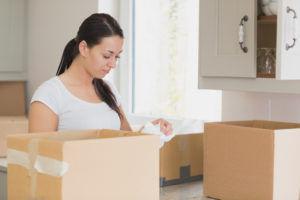How to Pack Up a Kitchen: Advice From the Expert Movers and Packers at Hall Lane
Posted on: November 15, 2018 | by: admin
Kitchens tend to be full of glassware, ceramics, and other breakable items, so many of our clients feel stressed about getting their kitchens packed correctly and carefully. The movers and packers at Hall Lane have compiled their best tips about how to prepare for your next move, including how to protect all your kitchen goods.

Packing up your kitchen is a great opportunity to take inventory of what items you own. As you prepare for your move overall, you might be organizing sell piles or donate piles in other parts of your house. The kitchen is no exception. If you find you have duplicate items, or rarely used items that are still in good shape, consider rehoming them with friends or family, or donating them to a local charity.
The movers and packers at Hall Lane know that a kitchen is full of items of varied sizes, weights, and materials. This means that you should prepare for packing by having boxes of different sizes, and lots of packing materials like packing peanuts, or bubble wrap. For kitchen items, you won’t want to use newspaper as a packing material—the ink can rub off onto textured surfaces, and you don’t want to have to rewash every item in your kitchen as you unpack in your new home!
As you get ready to start packing, note that items of similar weights and materials should be packed together to prevent damage. For instance, a heavy ceramic bowl packed next to a lightweight glass plate is almost certain to cause some damage during moving. Thinking about the shapes of items you could stack or pack together can also help prevent damage.
Another consideration from the movers and packers at Hall Lane is which items you’ll need ready access to in your new home. These are probably also the items you’ll want to pack last in your old home. Consider reserving a few plates, bowls, cups, and silverware settings, as well as a few baking items as needed, and reserving a box or two to pack these items. Label them as “urgent” or some other label so that you know which boxes contain the kitchen items you most need. This way, you can pack them last, and unpack them first. You can also consider using paper plates, paper napkins, and other disposable solutions as you transition into your new space.
Note that the number one mistake our movers and packers see in the kitchen is plates stacked horizontally, or length-wise in the box. Plates and other flat items should be stacked vertically in a box that has plenty of padding on the bottom. Because of their shape, plates are more vulnerable to cracking or breaking when they are packed flat or horizontally. As you pack your plates, use plenty of layers of packing paper, or consider using oven mitts, kitchen towels, and other soft items strategically between plates.
Kitchen appliances tend to be both awkwardly shaped, and delicate. The movers and packers at Hall Lane recommend using the original box and packaging if it’s available. If not, use a box slightly larger than the appliance to pack it. Start by layering the bottom of the box and the sides with bubble wrap. Gently place the item into the box, and fill in any void spaces with packing peanuts or packing paper.
Mark boxes with appliances, glassware, vases, and other delicate items “fragile” to help your movers know which boxes contain delicate items. For the boxes you’ve packed with plates or other flat items, be sure to mark the sides of the box with “this way up” to be sure they are stacked correctly on the moving van. Label your boxes with dark permanent marker, in large and clear writing.

